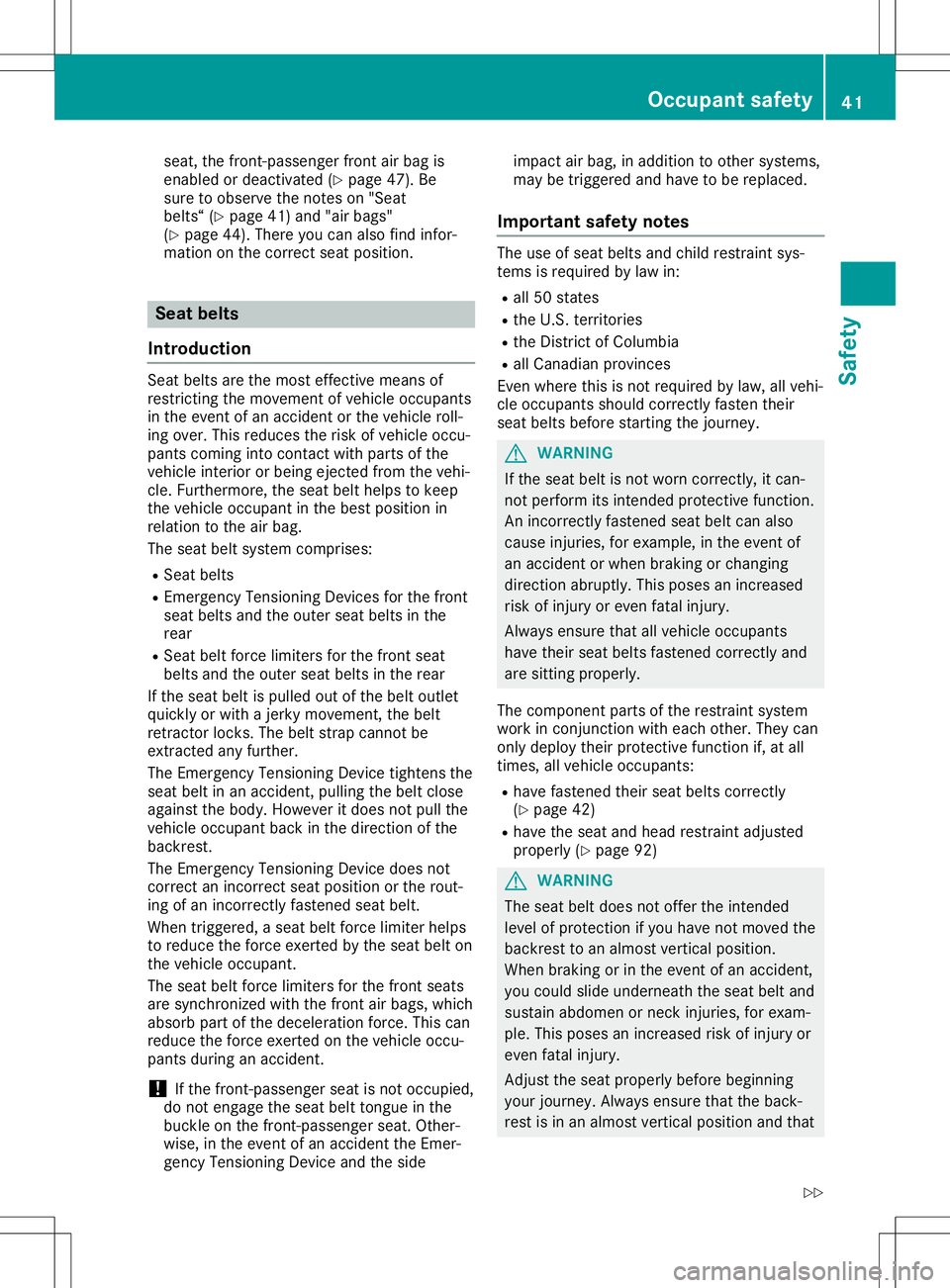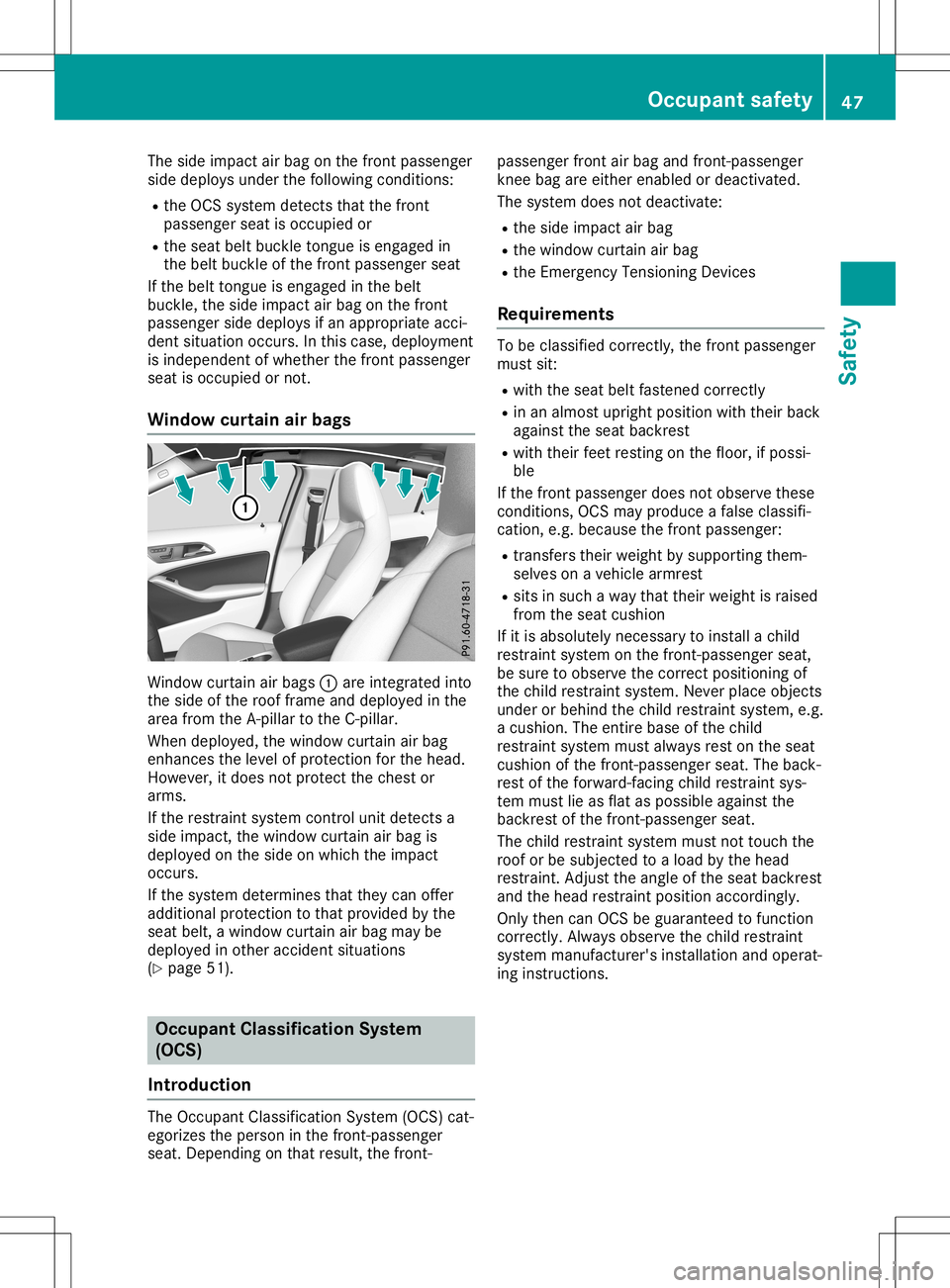deactivate passenger airbag MERCEDES-BENZ GLA SUV 2020 Owner's Manual
[x] Cancel search | Manufacturer: MERCEDES-BENZ, Model Year: 2020, Model line: GLA SUV, Model: MERCEDES-BENZ GLA SUV 2020Pages: 346, PDF Size: 51.22 MB
Page 43 of 346

seat,
thefront -passenger frontairbag is
enabled ordeactivated (Ypage 47).Be
sure toobserve thenotes on"Seat
belts“ (Ypage 41)and "airbags"
(Y page 44).There youcan also findinfor-
mation onthe correct seatposition. Seat
belts
Introduction Seat
belts arethe most effective meansof
restrict ingthe movement ofvehicle occupants
in the event ofan accident orthe vehicle roll-
ing over. Thisreduces therisk ofvehicle occu-
pants coming intocontactwith parts ofthe
vehicle interior orbeing ejected fromthevehi-
cle. Furthermore, theseat belthelps tokeep
the vehicle occupant inthe best position in
relation tothe airbag.
The seat beltsystem comprises:
R Seat belts
R Emergenc yTensioning Devicesforthe front
seat belts andtheouter seatbelts inthe
rear
R Seat beltforce limiters forthe front seat
belts andtheouter seatbelts inthe rear
If the seat beltispull edout ofthe belt outlet
quickly orwith ajerky movement, thebelt
retractor locks.Thebelt strap cannot be
extract edany further.
The Emergenc yTensioning Devicetightens the
seat beltinan accident, pulling the belt close
agai nstthe body. However itdoes notpull the
vehicle occupant backinthe direction ofthe
backrest.
The Emergenc yTensioning Devicedoesnot
correct anincorrect seatposition orthe rout-
ing ofan incorrect lyfastened seatbelt.
When triggered, aseat beltforce limiter helps
to reduce theforce exerted bythe seat belton
the vehicle occupant.
The seat beltforce limiters forthe front seats
are synchronized withthefront airbags, which
absorb partofthe deceleration force.Thiscan
reduce theforce exerted onthe vehicle occu-
pants during anaccident.
! If
the front -passenger seatisnot occupied,
do not engage theseat belttongue inthe
buckle onthe front -passenger seat.Other-
wise, inthe event ofan accident theEmer-
gency Tensioning Deviceandtheside impact
airbag, inaddition toother systems,
may betriggered andhave tobe replaced.
Importa ntsafety notes The
useofseat belts andchild restraint sys-
tems isrequired bylaw in:
R all 50 states
R the U.S. territories
R the District ofColu mbia
R all Canadi anprovinces
Even where thisisnot required bylaw, allvehi-
cle occupants shouldcorrectlyfasten their
seat belts before starting thejourney. G
WARNING
If the seat beltisnot worn correct ly,itcan-
not perform itsintended protective function.
An incorrect lyfastened seatbeltcanalso
cause injuries, forexample, inthe event of
an accident orwhen braking orchanging
direction abruptly.This poses anincreased
risk ofinjury oreven fatalinjury.
Always ensurethatallvehicle occupants
have theirseatbelts fastened correctlyand
are sitting properly.
The component partsofthe restraint system
work inconj unction witheach other. Theycan
only deploy theirprotective functionif,at all
times, allvehicle occupants:
R have fastened theirseatbelts correct ly
(Y page 42)
R have theseat andhead restraint adjusted
properly (Ypage 92) G
WARNING
The seat beltdoes notoffer theintended
level ofprotection ifyou have notmoved the
backrest toan almost vertical position.
When braking orinthe event ofan accident,
you could slideunderneath theseat beltand
sustain abdomen orneck injuries, forexam-
ple. This poses anincreased riskofinjury or
even fatalinjury.
Adjust theseat properly beforebeginning
your journey. Alwaysensurethattheback-
rest isin an almost vertical position andthat Occ
upant safety
41Safety
Z
Page 49 of 346

The
side impact airbag onthe front passenger
side deploys underthefollowing conditions:
R the OCS system detectsthat thefront
passenger seatisoccupied or
R the seat beltbuckle tongue isengaged in
the belt buckle ofthe front passenger seat
If the belt tongue isengaged inthe belt
buckle, theside impact airbag onthe front
passenger sidedeploys ifan appropriate acci-
dent situation occurs.Inthis case, deployment
is independent ofwhether thefront passenger
seat isoccupied ornot .
Window curtainairbags Window
curtainairbags 0043are integr atedinto
the side ofthe roof frame anddeployed inthe
area from theA-pillar tothe C-pillar.
When deployed, thewindow curtainairbag
enhanc esthe level ofprotec tionforthe head.
However, itdoes notprotec tthe chest or
arms.
If the restr aintsystem controlunit detect sa
side impact, thewindow curtainairbag is
deployed onthe side onwhich theimpact
occurs.
If the system determin esthat they canoffer
additional protectiontothat provided bythe
seat belt, awindow curtainairbag may be
deployed inother accident situations
(Y page 51). Occupant
Classification System
(OCS)
Introdu ction The
Occupant Classification System(OCS)cat-
egorizes theperson inthe front -passenger
seat. Dependin gon that result, thefront - passenger
frontairbag and front -passenger
knee bagareeither enabled ordeactivated.
The system doesnotdeactivate:
R the side impact airbag
R the window curtainairbag
R the Emergen cyTensionin gDevices
Requir ements To
be classified correctly,the front passenger
must sit:
R with theseat beltfasten edcorrec tly
R in an almost upright position withtheir back
against theseat backrest
R with their feetrestin gon the floor, ifpossi-
ble
If the front passenger doesnotobserve these
condit ions,OCSmayproduce afalse classifi-
cation, e.g.because thefront passenger:
R trans ferstheir weight bysupporting them-
selves onavehicle armrest
R sits insuch away that their weight israised
from theseat cushion
If it is absolutely necessarytoinstall achild
restr aintsystem onthe front -passenger seat,
be sure toobserve thecorrec tpositionin gof
the child restraintsystem. Neverplaceobject s
under orbehind thechild restraintsystem, e.g.
a cushion. Theentir ebase ofthe child
restr aintsystem mustalway srest onthe seat
cushion ofthe front -passenger seat.Theback-
rest ofthe forward-fac ingchild restraintsys-
tem must lieasflat aspossible againstthe
backrest ofthe front -passenger seat.
The child restraintsystem mustnottouch the
roof orbe subject edtoaload bythe head
restr aint. Adjust theangle ofthe seat backrest
and thehead restraintposition according ly.
Only thencanOCS beguaranteed tofunct ion
correc tly.Always observe thechild restraint
system manufact urer'sinstallation andoperat-
ing instr uctions . Occupant
safety
47Safety Z